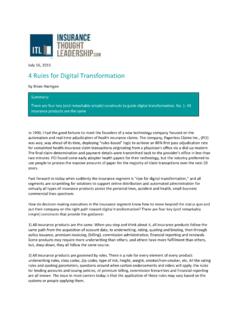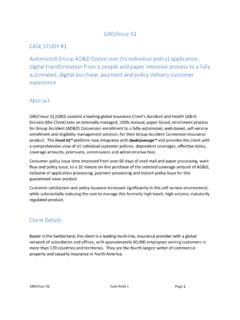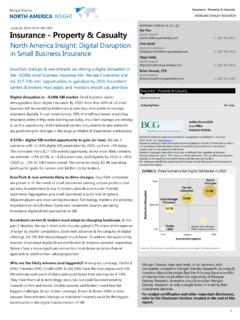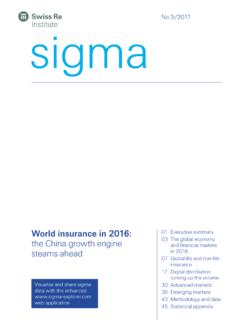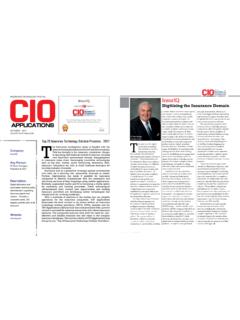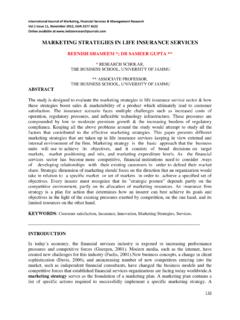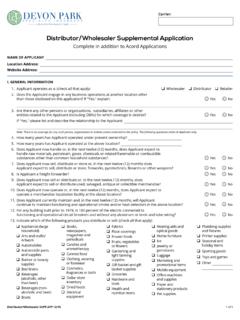Transcription of InsureTech - Omidyar Network
1 1 What Do Emerging Market Consumers Expect from InsureTech ?by Alex LazarowDespite being one the world s oldest and largest industries, insurance still fails to reach billions of people across the world. Globally, only 5 percent of low-income people have access to a necessity in developed markets, insurance always an intangible product that must be purchased when consumers don t need it is both poorly understood and often ill-suited to the needs of low-income people in emerging markets. Lloyds estimates the global underinsurance rate leaves a potential market between to 3 billion new policies s because insuring the underbanked is hard. The distribution costs are high as the adage goes, insurance is sold, not bought, but also, there hasn t been a low-cost channel to receive premiums and pay out claims. The ticket size is small. There s limited data about consumers and their title to price risks, and it s challenging to assemble a large enough pool of consumers for actual few years ago, we saw the same thing with credit: There were low levels of penetration, driven by the high cost of reaching and servicing clients, limited credit performance data, low collateral, and barriers to scale, which all contributed to raise marginal 2017 insurance still fails to reach billions of people across the world.
2 Globally, only 5 percent of low-income people have access to , access to credit seems to be expanding quickly in emerging markets. M-Shwari, the mobile banking service based on M-PESA, has more than 20 million customers in Kenya and Tanzania, is expected to expand to other 10 countries by 2020, and processes about 80,000 loans per day in Kenya Accounts tied to Aadhaar are connecting millions in India with formal s brought us to this tipping point is a convergence of technological trends. Mobile money has proliferated rapidly. At the same, a variety of startups are using nontraditional data to assess creditworthiness, making small unsecured loans more convenient and affordable. Taking advantage of these trends, a wave of startups as well as incumbents in many markets are targeting the underbanked with digital credit. For example, and Tala have raised $ million4 and $41 million, respectively, to expand mobile financial services in sub-Saharan Africa using smartphone data.
3 InsureTech Takes OffWe believe these same technological advancements could disrupt the insurance market globally and bring about the same tipping point that credit has achieved. The much newer insurance technology space is growing rapidly. The newly coined term InsureTech has taken off since early 2015. That year, there were $ billion in private financing across 122 deals in the InsureTech space, up from $582 million the year before. In 2016, 173 new deals were financed, totaling $ far, most of these companies are launching in developed markets, but the technology and business models they re pioneering have exciting potential to tackle the challenges that have historically made it uneconomical to insure low-income consumers in emerging markets. InsureTech ventures are experimenting with a variety of innovations in: distribution and customer acquisition: The first InsureTech companies took advantage of the combination of mobile delivery and mobile money to develop new models of customer acquisition and distribution .
4 For example, our investee MicroEnsure partners with mobile Network operators to sign up consumers for low-cost insurance and leverages mobile money for payouts. Data and analytics: Companies are beginning to use data from social media and the Internet of Things to perform more accurate measurement and scoring. For example, Metromile charges car insurance premiums based on how many miles you drive, and Carpe Data provides big data analytics, such as from connected home thermostats and devices, to help insurers better assess risk, while using social data to estimate customer retention, fraud likelihood, and customization: Startups such as Trov are disrupting the static, one-size-fits-all lumpiness of insurance policies, putting consumers in charge of exactly what they protect, when, and for how much. Most of these models are based on mobile delivery, with automated claims from a smartphone app. So far, they re mostly available in developed markets, but the potential in emerging markets is exciting: What if a family in Vietnam could buy insurance for their scooter, only when they ride it, based on how many passengers, and on where and how they drive it?
5 The newly coined term InsureTech has taken off since early 2015. In 2016, 173 new deals were financed, totaling $ , these innovations allow insurers to offer more flexible, more accurately priced policies, at ticket sizes small enough to be affordable to the uninsured in emerging markets. But seldom are emerging market consumers asked whether they would like these types of innovations. So, we Network commissioned RIWI Corporation to conduct an attitudinal, quick-response web survey across four countries: Kenya, Indonesia, Brazil, and the United States. It s not academic, but it offers some useful perspectives and direction for players in the insurance market and to Share Data for Greater AccessConsumers in emerging markets, particularly from lower-income countries, were willing to share some personal data (such as allowing an insurance provider to track their driving) in return for more affordably priced insurance .
6 Consumers with the least access to insurance , and from the lowest-income countries, were more willing to share data. This was true across all types of insurance . Between 56 and 63 percent of surveyed consumers in Kenya, and between 35 and 51 percent in Indonesia said they d allow an insurance provider to track their data. While only between 30 and 39 percent of consumers in middle-income countries, represented by Brazil, also in emerging markets, particularly from lower-income countries, were willing to share some personal data in return for more affordably priced to providing personal data for ..63%56%59%Kenya51%35%43%Indonesia39%30% 33%Brazil45%40%48%United StatesPhysical activityDrivingHome behaviorThis is consistent with Omidyar Network s existing research on alternative data-based credit assessment. In our report, Big Data, Small Credit, we found that consumers were willing to exchange their private data in exchange for bigger or better loans.
7 However, consumers think of privacy on a continuum, with some information considered more private and some less private. 44 Thus, consumers interest in sharing data varied by the type of behavior that would be tracked. In all three emerging markets, more consumers were willing to share driving behavior, then data on physical activity (such as from a wearable activity tracker). Fewer consumers were willing to allow tracking of their home behavior (such as how often user is home, whether doors are left unlocked, and whether stove is turned off), considered the most invasive Resounding Interest for CustomizationWhile some companies are pursuing product customization models, like Trov allowing customers in the US to build bespoke levels of insurance , and even switch protection on and off data from our survey did not indicate the majority of consumers would prefer this approach. Overall, at least 72 percent of respondents were not interested in insuring specific items, insuring them for a specific amount of time, or paying premiums based on usage.
8 However, about a quarter of the population, trending younger and more urban, was very interested, so it may still be an important product for this with data sharing, the potential may be greater in lower-income countries. Kenya was the only country where more than 40 percent of respondents were interested in covering only specific household items, or covering items for a short time a quarter of the population, trending younger and more urban, was very interested, so it may still be an important product for this aggregated across all 3 emerging marketsNot willing to share personal dataWilling to share personal data50%49%55%45%Physical activityDrivingHome behaviorGDP per capita, PPP (constant 2011 USD)6$2,901$10,385$14,455$52,549 Interested in non-traditional forms of insurance ..KenyaIndonesiaBrazilUnited StatesCovering only specific household items42%22%17%33%Covering short time periods for personal items42%21%17%29%Paying a premium based on car usage38%22%16%30%Utilizing partial insurance for a lower premium38%20%18%28%55 What s Next for InsureTechThis attitudinal survey gives us a high-level view of the potential market for InsureTech based on alternative methods of measurement and scoring.
9 We now have an opportunity to dig deeper so we can understand the business models, approaches to product design, and technology that will be most successful in reaching underserved s little doubt we ll see InsureTech continue to scale in the US, but at Omidyar Network , we still believe the real opportunity is in emerging markets. Consumers are open to innovation, even if more customer education and more experimentation is required. And the trends converging that have given rise to InsureTech ( digital distribution , automated claims, big data analytics) are poised to continue to achieve scale in emerging markets, providers will need more population and attitudinal data, as well as a roadmap for product innovation. It will be interesting to see what InsureTech product scales first in the developing world. Our investee MicroEnsure has had traction through partnerships with mobile Network operators serving more than 50 million customers in 20 countries but they re still in the early stage of understanding this market.
10 InsureTech providers will need to build the right partnerships not just for distribution , but also for data gathering, balance sheet strength, and product new markets, managing risk will be crucial. This also hinges on data gathering. InsureTech gives us exciting new channels and models to reach the underserved, but it s also going to take some good old-fashioned groundwork to achieve Lazarow (@Alex_Lazarow on Twitter) is an investments principal with the philanthropic investment firm Omidyar : This survey was delivered to 47,692 people across four countries: 7,588 in Brazil, 7,430 in Indonesia, 4,956 in Kenya, and 27,718 in the US, via Random Domain Intercept Technology (RDIT). Samples are not statistically significant to represent general opinion and questionnaire completion rates varied by country and question. RDTI delivers anonymous opt-in surveys to random internet users who are surfing online by typing directly into the URL bar.
